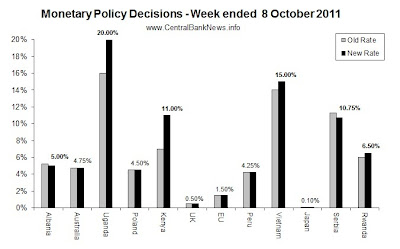Fundamental Forex Market Outlook for the Upcoming Week
The key fundamental economic events that can strongly influence the forex market this week feature the U.S, Canadian and Chinese Trade Balance data due out on Thursday, and the G20 Meetings which are scheduled for Friday and Saturday. Additional key economic releases due out this week are detailed further below, with the current market consensus expectations or the last result included in parenthesis whenever available.
Monday will be a Bank Holiday in the United States, Canada and Japan, and the day’s major economic data features ANZ Job Advertisements (last -0.6%). Tuesday’s key  economic events include a speech by ECB President Trichet, UK Manufacturing Production (-0.1%) and Canadian Housing Starts (187K).
economic events include a speech by ECB President Trichet, UK Manufacturing Production (-0.1%) and Canadian Housing Starts (187K).
On Wednesday, the market will closely monitor Aussie Home Loans (1.1%), the UK Claimant Count Change (24.4K), and the FOMC’s Meeting Minutes.
Thursday will see the release of the Aussie Employment Report that includes the Employment Change (10.1K) and Unemployment Rate (5.3%), as well as the Chinese Trade Balance (17.1B), Canadian Trade Balance (-0.9B), the U.S. Trade Balance (-46.2B) and the closely watched U.S. Weekly Initial Jobless Claims (407K) data.
Friday’s schedule features Chinese CPI (6.1%), the first day of the G20 Meetings, U.S. Core Retail Sales (0.2%) and Retail Sales (0.5%), as well as the Preliminary University of Michigan Consumer Sentiment survey (60.2). Saturday will conclude the week with the final day of the G20 Meetings and the expected release of its latest communiqué.
Technical Forex Market Outlook for the Upcoming Week
EUR/USD:
Weekly Forecast: Higher
Resistance: 1.3450, 1.3494, 1.3520/24, 1.3566, 1.3586, 1.3689, 1.3720, 1.3743, 1.3796, 1.3936, 1.3972, 1.4103, 1.4147, 1.4258, 1.4279, 1.4327 and 1.4499/1.4503.
Support: 1.3384, .13362, 1.3333, 1.3241/44, 1.3145, 1.3055, 1.3000, 1.2968, 1.2873, 1.2733, 1.2643 and 1.2586.
200-day MA: 1.4056 and slowly rising.
14-day RSI: 38.3 and rising.

USD/JPY:
Weekly Forecast: Somewhat higher
Resistance: 76.88/77.06, 77.19/37, 77.71, 77.85, 78.02, 78.66, 79.05, 79.40, 80.00, 80.22, 80.82, 81.34, 81.76, 82.01/22, 82.77, 83.09 and 83.77.
Support: 76.50/69, 76.32, 76.25, 76.14, 76.10, 75.94, 75.00 and 70.00.
200-day MA: 80.31 and falling.
14-day RSI: 50.0 and flat.

GBP/USD:
Weekly Forecast: Higher
Resistance: 1.5632, 1.5644, 1.5664, 1.5685, 1.5705, 1.5714, 1.5745, 1.5839, 1.5867, 1.5883, 1.5912/19, 1.5951, 1.6000, 1.6037, 1.6081, 1.6130, 1.6204/06, 1.6252/59, 1.6332/47, 1.6434/52 and 1.6500/98.
Support: 1.5525/31, 1.5483, 1.5422, 1.5373, 1.5339/55, 1.5326, 1.5293, 1.5270, 1.5123, 1.5000, 1.4947, 1.4872, 1.4785/97, 1.4500, 1.4474, 1.4345 and 1.4229.
200-day MA: 1.6128 and flat.
14-day RSI: 42.0 and rising.

USD/CHF:
Weekly Forecast: Lower
Resistance: 0.9277, 0.9294, 0.9300, 0.9313, 0.9327, 0.9339, 0.9368, 0.9774/83, 0.9971, 0.9997, 1.0000 and 1.0065.
Support: 0.9141/60, 0.9020, 0.9000, 0.8994, 0.8979, 0.8916/26, 0.8883, 0.8873, 0.8797, 0.8788, 0.8728, 0.8646, 0.8622, 0.8536, 0.8239 and 0.8000.
200-day MA: 0.8787 and falling mildly.
14-day RSI: 71.5 overbought and flat.

AUD/USD:
Weekly Forecast: Higher
Resistance: 0.9842/76, 0.9953, 0.9984, 1.0000, 1.0077, 1.0146, 1.0176, 1.0296, 1.0310, 1.0347, 1.0360, 1.0373/96, 1.0473, 1.0481, 1.0511, 1.0564/70, 1.0599, 1.0624, 1.0633, 1.0659, 1.0683/93, 1.0718/26, 1.0763, 1.0784, 1.0909, 1.1000/15, and 1.1064/79.
Support: 0.9732, 0.9689, 0.9667, 0.9651, 0.9620/27, 0.9536/41, 0.9500, 0.9462, 0.9386, 0.9330, 0.9220, 0.9077, 0.9000, 0.8870, 0.8858, 0.8632, 0.8550 and 0.8066/81.
200-day MA: 1.0376 and falling mildly.
14-day RSI: 39.7 and rising.

USD/CAD:
Weekly Forecast: Lower
Resistance: 1.0417, 1.0481/90, 1.0500, 1.0506, 1.0646/56, 1.0669, 1.0742, 1.0756, 1.0785, 1.0853, 1.0868, 1.1000 and 1.1101/23.
Support: 1.0322, 1.0255, 1.0233/36, 1.0208, 1.0139, 1.0088, 1.0057, 1.0030, 1.0008, 0.9939/1.0030, 0.9828/77, 0.9763/96, 0.9734/39, 0.9724, 0.9686, 0.9645, 0.9567, 0.9526, 0.9496, 0.9448/56, 0.9422, 0.9405/09, 0.9056 and 0.9000.
200-day MA: 0.9793 and rising mildly.
14-day RSI: 63.2 and falling.

NZD/USD:
Weekly Forecast: Higher
Resistance: 0.7716, 0.7750/54, 0.7795, 0.7816, 0.7851, 0.7892, 0.7950/62, 0.8000/44, 0.8060/93, 0.8109/19, 0.8126/40, 0.8150/90, 0.8269/78, 0.8327/39, 0.8365/86, 0.8423, 0.8469/72, 0.8500, 0.8534/75, 0.8676, 0.8764, 0.8793 and 0.8841.
Support: 0.7672, 0.7626/35, 0.7605, 0.7549, 0.7523, 0.7504, 0.7500, 0.7453/67, 0.7426, 0.7404, 0.7342, 0.7321, 0.7189, 0.7115, 0.7000 and 0.6945/62.
200-day MA: 0.7955 and flat.
14-day RSI: 37.0 and rising.

Get this report to your email by signing up for our newsletter!





















